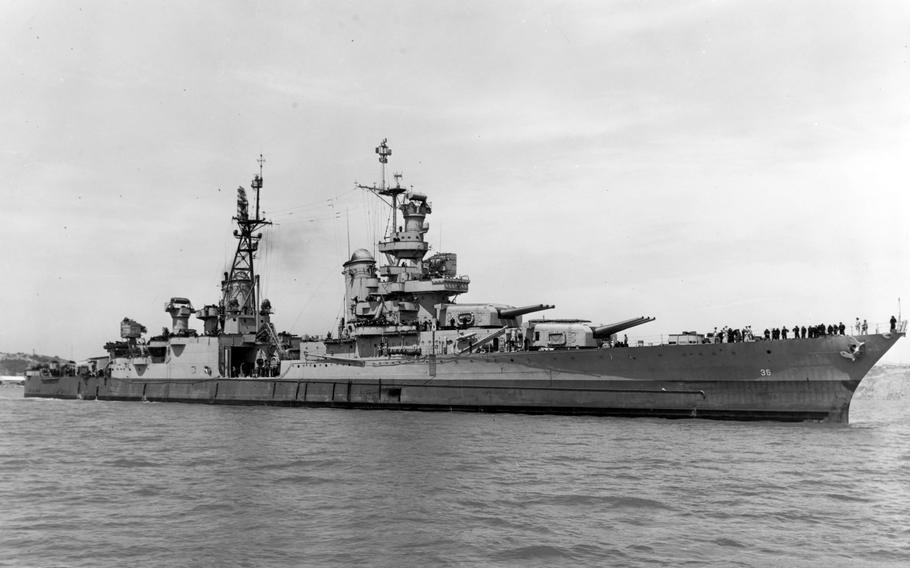
The USS Indianapolis off of Mare Island on July 10, 1945. (National Archives)
It was during the 1800s that the practice of grave robbing — stealing bodies from cemeteries — was in full swing. It became a profitable activity for those involved as they easily found an unlimited market for their “product” among medical schools, especially as the number of them proliferated. Due to the need to study anatomy, the schools believed the practice was a necessary evil and, hence, would never make inquiries as to how sellers acquired their bodies. Not until the late 19th or early 20th centuries did most states outlaw the practice.
Today, although little is written about it, the practice of “deep sea” grave robbing is in full swing. Ironically, these grave robbers couldn’t care less about the bodies disturbed by their activities, as their focus is on that in which the remains are entombed — the pre-World War II steel that went into constructing many of the ships sunk during that conflict.
Why the interest in pre-World War II steel? Interestingly, due to atomic bomb testing as well as the two bombs dropped on Japan to end the war, all steel manufactured after the war has been “irreversibly irradiated with radioactive cobalt isotopes during the process of mixing iron and carbon as an unexpected consequence” thereof. Thus, there is a market for pre-World War II (or what is known as “low-background”) steel for manufacturing items sensitive to radiation. These include certain scientific and medical equipment, especially that required in high-tech research.
One can only imagine, due to the cost of extracting steel from these underwater gravesites, how much profit must be involved in selling low-background steel — with buyers, just like the medical schools in previous centuries, not too concerned about its sourcing. But our oceans are a target-rich environment for these steel salvagers, as it is estimated there are at least 6,000 ship gravesites as a result of World War II.
While it is pretty much open season on salvaging steel from sunken non-military vessels, legally it is not the same for military ships. They remain the property of the flag of the nation flown at the time of their demise. Interestingly, this international maritime law did not go into effect until after the Cold War, which allowed the U.S. to conduct the partially successful covert recovery of a Soviet submarine in 1974 under the guise of mining for subsea manganese nodules.
But the above law has not inhibited these deep sea gravesite robbers from plying their trade as numerous warships belonging to different nations have been stripped of their steel, with no concern given to the desecration of the bodies within. Three Japanese cargo transports sunk during World War II off the coast of Borneo have suffered this fate. What remains of the ships is described as “an unrecognizable heap of metal piled up into a ball.”
It is estimated that 13 million tons of sunken warships containing the remains of tens of thousands of war dead lie deep in the waters of the Pacific Ocean. At least 40 of these gravesites have already been stripped of their low-background steel.
Steel salvaging operations strip ship gravesites of their sanctity — a place where courageous sailors met their mortal end and should be revered. But steel salvaging has become so commonplace that researchers who now discover historical wrecks refuse to publicize the locations. One of the most famous of these was the USS Indianapolis, sunk by two Japanese torpedoes weeks before the war’s end and not discovered until 2017. The ship was famous for the secret mission it had just completed — delivering parts of the atomic bomb to Tinian to a B-29 bomber that would later drop the first one on Japan — and in which the remains of 300 sailors are still entombed.
In May 2005, the USS Lagarto — a submarine that was inexplicably lost during World War II — was located in the Gulf of Thailand. The next year, the U.S. Navy sent dive teams onboard the USS Salvor to explore the gravesite to see if any remains were recoverable. My son was among those team members. The dives revealed the submarine to still be intact, obviously with all crewmembers still entombed. Seeing no need to disturb the site, the dive team simply placed a plaque on it noting the ship’s “Eternal Patrol.”
Just like the Lagarto and its crew were revered generations later by these Navy divers, so too should the gravesites of these warships and the courageous sailors who went down with them be revered by all. Buyers of low-background steel who simply consider such desecration to be a necessary evil dishonor those who sacrificed their lives for our freedom.
James Zumwalt is a retired Marine infantry officer (lieutenant colonel) who served in the Vietnam War, Panama and Operation Desert Storm. He is the author of three books and hundreds of opinion pieces in online and print publications.